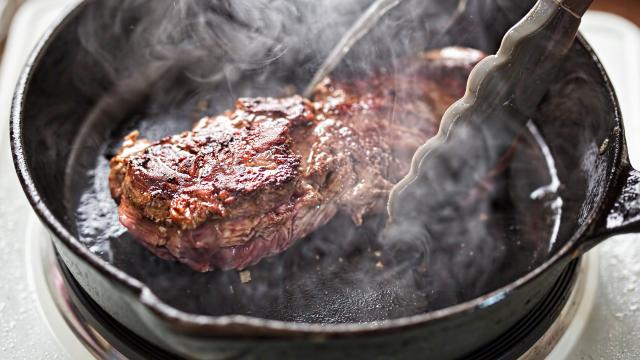I hate talking about cast iron. It’s just a pan (or a material with which they make pans, Dutch ovens, etc.), but it’s a pan that brings all the nerds to the yard, and they’re like “my seasoning method is better than yours.” They love to talk about thermal conductivity and polymerization, two subjects I’ve tried my best not to think about since I left my job at Honeywell and convinced people to pay me to write about food.
Thermal conductivity and polymerization are relevant subjects — and I will, begrudgingly, touch on that second one in a moment — but all this nerd talk shifts focus away from the most important cast iron tip out there: The best way to care for your precious cast iron pan is to use it. Cook food in it, especially greasy food. Once you eat that food, clean the pan and cook something else. Keep doing this over and over, and you’ll notice that your pan gets better, and less sticky, with each use.
This does, unfortunately, come down to polymerization. When you heat oil and grease to high temps, they break down and form long chains of molecules that bond to the surface of your pan. This creates the nonstick coating that the nerds are always going on and on about, and it’s also what makes it possible to wash your cast iron pan with soap.
Washing cast iron with soap and water has been an acceptable practice for almost a decade now, but there are still some nerds out there who get weird about it. There is, however, no reason to get weird about this particular pan. If you don’t believe me, believe Kat Kinsman, a very smart woman with a masters degree in metalsmithing who just happens to be the senior editor at Food & Wine. Two years ago, Kat wrote “Don’t Be Weird About Cast Iron,” in which she documents the restoration of a truly crusty, rusty pan she found in an old chicken shed, essentially proving that — with the exception of cracking — you really cannot fuck these pans up past repair, and that’s what makes them so valuable. Cast iron doesn’t need your babying, your fussing, your anxiety. It just needs to be cooked in.
To confirm that you don’t need to be weird about washing your cast iron, Kat called up Mike Otterman, the CEO of Lodge, to get his cast iron care routine, and it is notably not weird or nerdy:
After dinner, I’ll scrape it out in hot water. I will use soap and rub it down on the interior, particularly if I do salmon or something like that. Then I put it back on the burner on low, straighten up the rest of the kitchen. When it gets up to a nice warm temperature, I spray it with oil, turn off the burner, wipe it down with a paper towel, leave it on the burner until it cools and then I obviously never put it away. It looks better when I’m done cooking with it than I did when I started it.
But cleaning is only part of the cast iron care equation. Again, the best thing you can do for your cast iron pan is to use it over and over. If your pan is brand new, follow the manufacturer’s “first use” instructions, then start cooking, and never stop. (Lodge pans come pre-seasoned and ready to go, right out of the box.)
Start with something greasy that’s unlikely to give you any stickage problems. I usually cook a bunch of bacon. Then roast some veggies, or a chicken. Wipe it out, and wash it if needed, then dry it and grease it up again. Bake a pan of butter cornbread. Repeat. Try to clean it promptly, but don’t fret if you don’t. No matter how gunky the pan gets, you will be able to get it clean again. Even if your roommate or spouse leaves it soaking in the sink, you will be able to restore it back to its gleaming glory. (If you ever doubt this, just look at where Kat started with her chicken shed pan.) The more you cook, the more nonstick your cast iron will become. Eventually, you’ll be able to fry an egg in there — a task the nerds view as the holy grail of a “properly” seasoned cast iron pan.
Oh, and if you’re reading this and don’t have a cast iron pan but want one, here is our guide to buying your first pan, as well as are our top picks.

Leave a Reply
You must be logged in to post a comment.